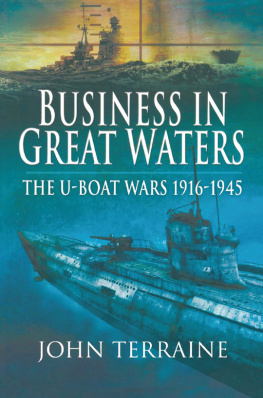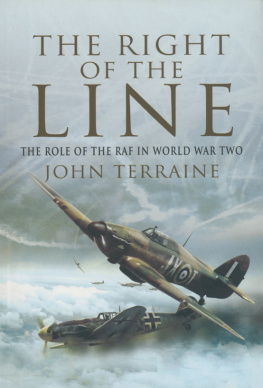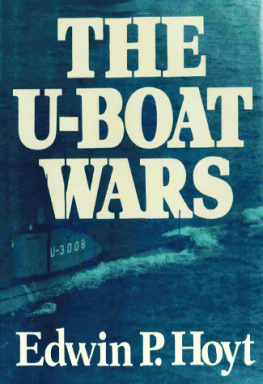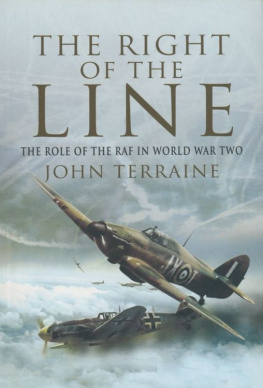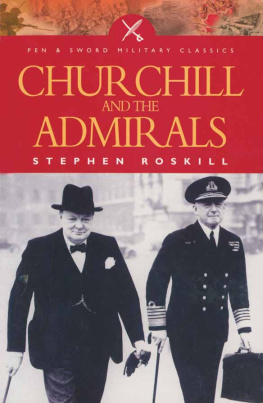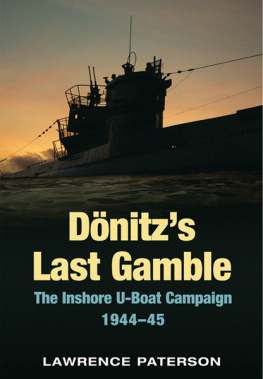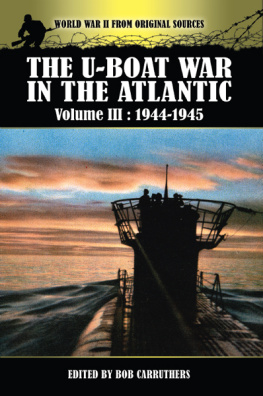BOOKS BY JOHN TERRAINE
MONS, THE RETREAT TO VICTORY
DOUGLAS HAIG: THE EDUCATED SOLDIER
THE WESTERN FRONT
GENERAL JACKS DIARY (ed.)
THE GREAT WAR: AN ILLUSTRATED HISTORY
THE LIFE AND TIMES OF LORD MOUNTBATTEN
IMPACTS OF WAR, 1914 AND 1918
DECISIVE BATTLES OF THE WESTERN WORLD
17921944 by J.F.C. Fuller (ed. 2 vols.)
THE MIGHTY CONTINENT
TRAFALGAR
THE ROAD TO PASSCHENDAELE
TO WIN A WAR: 1918 THE YEAR OF VICTORY
THE SMOKE AND THE FIRE: MYTHS AND ANTI-MYTHS OF WAR,
18611945
WHITE HEAT: THE NEW WARFARE 19141918
THE RIGHT OF THE LINE: THE ROYAL AIR FORCE IN THE
EUROPEAN WAR 19391945
First published by Leo Cooper Ltd, 1989
Reprinted in this format by
Pen & Sword Military
an imprint of
Pen & Sword Books Ltd
47 Church Street
Barnsley
South Yorkshire S70 2AS
Copyright John Terraine, 1989, 2009
ISBN 978 1 84884 135 2
The right of John Terraine to be identified as
author of this work has been asserted by him in accordance
with the Copyright, Designs and Patents Act 1988
A CIP catalogue record for this book is
available from the British Library
All rights reserved. No part of this book may be reproduced or transmitted
in any form or by any means, electronic or mechanical including
photocopying, recording or by any information storage and retrieval
system, without permission from the Publisher in writing.
Printed and bound in England
by CPI
Pen & Sword Books Ltd incorporates the imprints of
Pen & Sword Aviation, Pen & Sword Maritime, Pen & Sword Military,
Wharncliffe Local History, Pen & Sword Select,
Pen & Sword Military Classics and Leo Cooper,
Remember When, Seaforth Publishing and Frontline Publishing
For a complete list of Pen & Sword tides please contact
PEN & SWORD BOOKS LIMITED
47 Church Street, Barnsley, South Yorkshire, S70 2AS, England
E-mail: enquiries@pen-and-sword.co.uk
Website: www.pen-and-sword.co.uk
Illustrations
Maps
Drawn by Chester Read
TEN BOOKS ON the First World War published between 196082; a substantial statement on the Royal Air Force in the Second World War published in 1985; now U-boats, conducting Unrestricted Submarine Warfare between 191645: is there any connection between the subjects that have kept three decades of my life very fully occupied or does this diversity indicate mere dilettantism? I believe that a connection does exist and that it is an important one but I will readily confess that this perception is hindsight, and does not imply any deliberate intention at the time of writing, least of all when it all began some thirty years ago.
I belong to a generation to which the two World Wars were present realities marking the most impressionable part of a lifetime. In 1921, when I was born, my father worked in Brussels, where the signs of German occupation between 191418 were still visible even to a very small boy, where its weight still lay heavily on the people and continued to do so for the next eighteen years; I grew up with the Great War never far from peoples minds and very often in their conversation. And it was usually very difficult indeed to make head or tail of what they were saying. It was a mystery not surprisingly, because I should say that no event in history has ever been so steeped in mythology since the time of the Old Testament.
World War II, which I lived through in what I now consider to have been a state of incomprehension at least equal to my confusion about its predecessor, added new layers of mythology, fresh fantasies to addle the minds of young and old alike. However, these did not stand up for long to the harsh audit of peace (if I may borrow a phrase from Correlli Barnett). Birds which had been well on their way to the roost in the 1930s flocked home in the 1950s. 1956, I suppose, was the year when they arrived, and one could begin to measure the enormous change that the wars had brought, to Britain, to the British Empire, and to the world.
It was during that decade that I began thinking to some recognizable purpose about the wars, especially 1914 to 1918, to try to unravel some of the mysteries. My first book taught me my first lesson: Mons: The Retreat to Victory was commissioned for Batsfords British Battles series, and Mons has, indeed, occupied a significant pedestal in British legend, even including Angels! I learned that the truth was otherwise; General Smith-Dorriens half-day skirmish at Mons on 23 August, 1914 took on a different look when I contemplated the long battle-line of the French armies, grappling with their massive, well-trained, well-equipped and courageous German enemy. This struggle cost the French over 210,000 officers and men which is considerably more than the full strength of the British Expeditionary Force in the month of August alone: a sobering thought. It dawned on me that exclusive inspection of the British contribution would not supply adequate explanation of the First World Wars mysteries and soon I also recognized that the same was true of World War II. If the British Battle at Mons in 1914 shrinks perceptibly in the perspective of the main action on the main front, so, I fear, does the British Battle of El Alamein in 1942.
More and more, as one book followed another, I became concerned with this matter of the main front and the main action the decisive point, or what the Germans would call the Schwerpunkt. I did not, for a very long time, express it, even to myself, with such precision, but it steadily became my preoccupation: the Schwerpunkt, the centre of gravity of each of the two wars. And that is the connection: the Western Front in World War I, where first the French and then the British Armies bore the burden of the main action against the main enemy; the RAF, taking its position on the Right of the Line in World War II; and the defeat of the U-boats, which in 1943 provided the only means by which the Western Allies could deploy their full forces against the main enemy once again. I was well aware that this amazing enterprise was not, in fact, the Schwerpunkt of World War II itself, which from June 1941 was always on the Eastern Front, where the German Army was ground down in even costlier Verduns, Sommes and Passchendaeles with Russian names. Yet as far as Britain and America were concerned, Operation OVERLORD was the main action of the German war, and that was no light matter.
My aim in this book has been to try, as far as a single volume permits, to identify and observe the ingredients of submarine and antisubmarine war. They belong very firmly to the new warfare of the Industrial Revolution whose nature was first glimpsed in America between 186165, and which bared its teeth in World War I. It was a warfare which owed almost everything to Technology and which demanded the ever-increasing participation of Science. It called into existence a new anti-submarine armament ship- and air-borne depth charges, bombs and projectors, acoustic and magnetic mines and torpedoes, U-boat detectors (Hydrophones, ASDIC and magnetic), special vessels and aircraft loaded with instruments and devices of wonderful sophistication. It made heavy demands on discoveries like Radar, on Wireless Telegraphy and the intercepts thereof, on Direction-Finding, on Radio-Telephony and always, unceasingly, on the courage, endurance, ingenuity and skill of the men in the U-boats, the men who fought them at sea and in the air, and the helpless merchant seamen who were their quarry or their wards.
As always in such studies, I was struck by the great advances made (on both sides) between 191418; if I were to rewrite this book, I would give even greater emphasis to this. Equally striking was the astonishing readiness in Britain and America between the wars to forget so much that had been learned so painfully. The unity of the whole unrestricted submarine warfare period, from its effective beginnings in 1916 right up to the last actions in 1945, speaks, I think, for itself. It is the unity of a finite story, an unique phase in technological development. Nothing quite like it will be seen again for the simple reason that the nature of the beast has changed. The U-boat wars were not really submarine warfare at all; they were fought by submersibles torpedo boats with the power to dive. It certainly surprised me to see how tightly the U-boats were locked to the surface, and this, in most cases, was what caused their downfall. When, at the very end, the Allies made a brief encounter with vessels approximating to true submarines, their techniques were rendered obsolete. So the story ended with a bleak view of what I have called the unappealing landscape of
Next page
